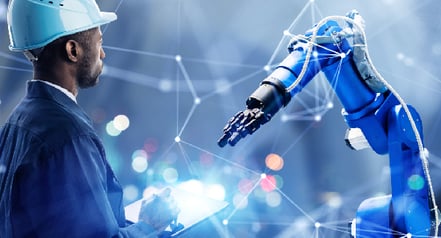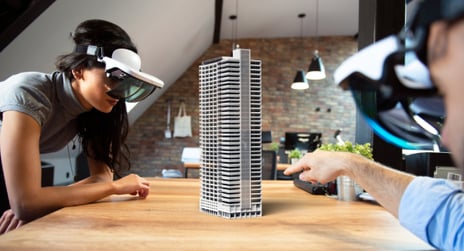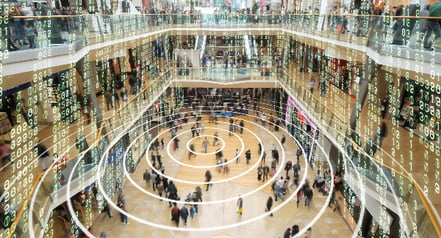
The technology allows us to anticipate problems, simulate scenarios, and make decisions with remarkable foresight. The use cases are extensive and cut across sectors. So much so, in the U.S. alone, MarketsandMarkets research suggests that the digital twins market—worth US$3.8 billion in 2019—is projected to reach US$48.2 billion in value by 2026.
Improvements in simulation and modeling technologies—cloud computing, IoT technologies, and advanced analytics—impact this growth and make digital twins more accessible. This means companies, regardless of size or industry, can now benefit from digital twins.
With technology picking up steam, we’ve taken a look at six ways digital twins could transform the world around us.
1. Reduce Manufacturing Downtime

Many agree the manufacturing sector holds the most compelling promise when it comes to digital twins.
The innovative technology is set to impact the way products are designed, manufactured, and maintained. As discussed in Deloitte’s report, ‘Industry 4.0 and the digital twin: Manufacturing meets its match’, the technology replicates what is taking place in real-time. They provide essential data on an item’s design and use and the system that built it.
In manufacturing, digital twins aid predictive maintenance—a technique to monitor and record the performance of an asset over time to predict its future and resolve issues before they arise. An engineer can monitor operational data and predict when a part needs replacing based on how the piece is acting; for example, if a wheel is turning at a slower rate, the engineer will think they need to replace the cog. This process helps reduce dreaded downtime.
2. Promotes Sustainable Housing

In recent years, there has been a huge push for digital twins in the housing sector, particularly in government-managed social housing.
This is due to the need for true transparency and accountability in the building sector. Conversations around the implementation of the golden thread in the wake of the Grenfell tragedy—one of the UK’s worst modern disasters in which a fire destroyed a residential tower block and killed seventy-two people—also play a huge role here.
Bola Abisogun, OBE, Chairman of DiverseCity Surveyors and a 27-year construction industry veteran, states that using rich data and visualization techniques would help us make smarter and more sustainable decisions for our communities. This, in turn, will allow us to deliver better quality homes—better insulated, improved fire safety regulations, and reduced carbon output in the house's energy usage. With digital twins, these homes will also have improved whole lifecycles.
3. Enhance Shipping & Logistics

In the logistics space, a supply chain digital twin allows for real-time digital awareness.
Here, digital twins can minimize disruptions of future operations while also improving them.
As noted by DHL, the global leader in the logistics industry, using digital twins, users can predict the performance of packaging materials, enhance shipment protection, and optimize warehouse design and performance.
They can also use the technology to create a dynamic delivery network using geographical data.
4. Using Sensors to Improve Healthcare

Digital twins can also impact us on a more intimate level.
A digital twin of a patient allows surgeons and health professionals to practice procedures in a simulated environment rather than on an actual patient.
Sensors are placed on patients to monitor their wellbeing.
Using the data and information collected by these sensors, a digital version of the patient can be created.
This digital version can then be monitored by artificial intelligence (AI) and used to improve care.
5. Building Better Cities

Cities have become early adopters of digital twin technology, with city planners using virtual models to gain a competitive edge.
A federation of connected models across sectors—transport, energy, water, and telecommunications—can improve how a city operates.
This includes construction progress, energy consumption, environmental conditions, public safety, waste management, security monitoring, mobility improvements, and infrastructure management.
Ultimately, digital twins can disrupt the way capital projects and infrastructure are planned, built, and operated.
6. Improve Retail Experience

Digital twins can even play a key role in improving the retail customer experience through customer modeling and simulations.
Retailers can create a digital representation of customer personas to enhance services and improve their product offerings.
As noted by Challenge Advisory, the UK management consulting firm, digital twins also optimize security implementation and support better in-store planning and energy management.
Overall, the capabilities of digital twins in this area could revolutionize how we buy and sell goods and services.
Early Stages, But Huge Potential
While digital twins in the real world are in the early stages of development and deployment, their potential to change internal processes across industries is striking.
Ultimately, they can be deployed anywhere to improve ongoing operations, train employees, and test new products or procedures before launching them. This means that when they’re ready for the real world, issues that may have been expensive and complicated to resolve are no longer a concern.
Want to learn more about how best to implement a digital twin on your project? Download our report now.
Asite Insights in your inbox.
Sign up for product news and our latest insights published monthly. It's a newsletter so hot, even global warming can't keep up.


